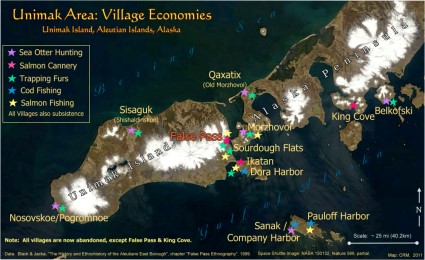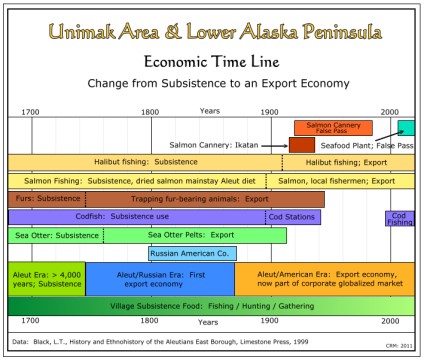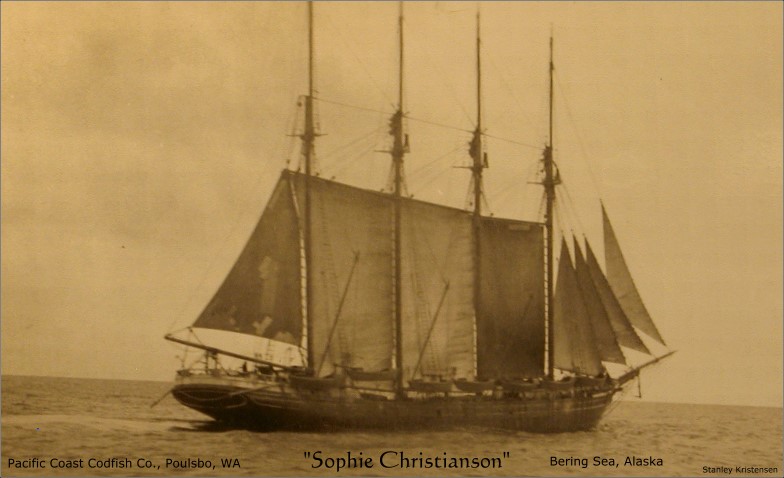
The Unimak Area village economies have always been based upon renewable, naturally occuring, living resources that came mostly from the sea. For nearly 5,000 years, the indigenous Aleut (Unangan) people flourished in this area on these locally abundant natural resources. Even though a variety of wild living resources were used and the Aleut population and wild species populations fluctuated over time, there seems to have been a dynamic equilibrium.1
When the export economy first developed under the Russian administration of the area and later expanced under the American administration, the pressure on the local renewable resources increased dramatically. By 1910 the sea otter population had been exterminated locally by over-exploitation. Codfish, that were once abundant, essentially disappeared in the late 1930's, only to re-appear around 1990, but this may have been naturally caused.3 Commercial cod fishing has resumed and along with halibut fishing, provides income for local fishermen. But, the backbone of the modern economy is the commercial fishing and processing of salmon. King Cove now has one of the largest sea food processing plants in the world.4 False Pass has a very small seafood processing plant, built after the salmon cannery burnt in 1981. Please see this website's pages on each village for detailed information on each local economy.
 Click on map to see larger version.
Click on map to see larger version.
The economic history of the Unimak Area has changed dramatically over time. The graph to the right shows the major economic resources used and how they changed from purely subsistence use to exportable commodities.
The Aleut subsistence economy, using local renewable resources was the first and longest lasting economy in the area. This period started with the first Aleut settlements in this area thousands of years ago. Its importance persists today on the village level, even though local people are now integrated into the modern market economy.
The Aleut-Russian export economy began shortly after the invasion by the Russians in 1741, when they realized that the region possessed valuable sea otter pelts and walrus ivory. These products could be sold for huge profits in China and Russia and they became the basis of the original Russian involvement in the Aleutian area. The Russian crown formalized this export economy by creating the Russian American Company in 1799 and this enterprise persisted until the American purchase of Alaska in 1867 when it became the Alaska Commercial Company.
The Aleut-American export economy began immediately after 1867 and focused initially upon sea otter pelts and other furs. The sea otter population was quickly over-exploited and crashed. The export economy then expanded to include the commercial fisheries. Cod was harvested first and salted locally for export, followed by salt salmon, then canned salmon, then halibut. Several families established fox farms on islands to supplement their income, but these disappeared when the fur market crashed. The fur market crash also brought an end to the trapping of wild fur bearing animals in the early 1940's.2

Click on graphic to see larger version.

Cod fishing and processing in the Unimak Area was done not only at shore stations, but at sea. (The shore stations are described on each village page on this website.) These sailing vessels did not need to come ashore except perhaps for fresh water, because they carried all their supplies with them from the home port "down below". The primary home ports for the schooners that fished in this area were Puget Sound in Washington state and San Francisco. The Sophie Christianson was one of these codfish schooners. She belonged to the Pacific Coast Codfish Co. (PCCC) from Poulsbo, Washington. Her captain and owner was Capt. J.E. Shields. The codfish were cleaned and dry-salted on the vessel and taken to Poulsbo for further processing in the shore plant there. These sailing vessels fished on the Shumagin Banks, the Sanak Banks and in the Bering Sea. The last vessel to fish for the PCCC was the C.A. Thayer with Ed Shields as captain. This voyage of the C.A. Thayer in 1950 was also the last sailing vessel in history to fish commercially in the Pacific Ocean. The Thayer is now in the National Maritime Museum, Fishermen's Wharf, San Francisco.6
References:
1) Maschner, Herbert D., "An Introduction to the Biocomplexity of Sanak Island, Western Gulf of Alaska.", Pacific Science, vol. 63, no. 4, p.682
2) Black, Lydia T., History and Ethnohistory of the Aleutians East Borough, Limestone Press, Fairbanks, 1999.
3) See recent article on cod at: http://www.marinemammal.org/2009/maschner.php
4) See Peter Pan Seafoods website at: www.ppsf.com
5) See APICDA's (parent company of Bering Pacific Seafoods in False Pass at: http://www.apicda.com/index.html
6) "Poulsbo's Captain Ed Shields crosses the bar", North Kitsap Herald, March 30, 2002